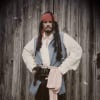Costume & Mask Fabrication Part 2: Secondary Forms & Foam Antlers/Horns
 Darrell Green
✭✭✭
Darrell Green
✭✭✭
I am so very impressed with how Fred can visualize fluid and elastic sculpting. This is hard to describe what I mean. Some people think in pictures. They can see in their mind what the sculpture should look like and they use additive or subtractive sculpture to get to a match in the real world. This is a common trait among artists. However, Fred is thinking far past this level because he is also visualizing his medium and how it expands and contracts to form to his vision. No one has to visualize what clay will do when you pinch it or carve it as it allways stays one density. Clay only changes shape but in expected ways. When clay is shaped, it is no longer in its previous form. Foam is still the same piece that was cut but is being stretched, compressed and directed into a new but still temporary shape. This type of visualization is akin to engineering in fluid dynamics, the actual science specialization. It is hard enough to tell someone what you see in your mind's eye, let alone describe to that person how to take an elastic source, cut it to a specified, non-final, shape and then push it, pull it and twist it into the position and bond it to create your mind's eye picture. And lest we forget, he is using numerous values of elasticisity and rigidity (different foams and materials) on purpose to meet these requirements. Aaaaaand, he even takes into consideration the mobility and movement, or lack there of, of the final shape, be it a non moving sculpture vs a flexible body suit. The ability to visualize all of that while designing and problem solving is truly a staggering feat, no exaggeration. I would really love to see what he is seeing in his mind when he pauses to build a verbal description of his processes.
1